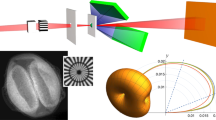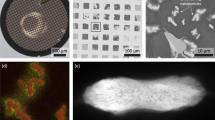Abstract
HERE we report an improvement to an autoradiographic technique1 for determining the spatial distribution in a solid of boron present at parts per million concentrations. The conventional technique is based on recording damage tracks produced by the products of the 10B(n,α)7Li reaction in cellulose acetobutyrate (CAB) and made visible in the optical microscope by etching in hot alkali solution. The technique using optical microscopy has a resolution of 1–2 microns and is sufficiently sensitive to show the distribution of about 0.5 p.p.m. of natural boron.
This is a preview of subscription content, access via your institution
Access options
Subscribe to this journal
Receive 51 print issues and online access
$199.00 per year
only $3.90 per issue
Buy this article
- Purchase on Springer Link
- Instant access to full article PDF
Prices may be subject to local taxes which are calculated during checkout
Similar content being viewed by others
References
Hughes, J. D. H., and Rogers, G. T., J. Inst. Metals, 95, 200 (1967).
Hughes, J. D. H. (in the press).
Author information
Authors and Affiliations
Rights and permissions
About this article
Cite this article
HUGHES, J., DEWEY, M. & BRIERS, G. Boron Autoradiography with the Electron Microscope. Nature 223, 498–499 (1969). https://doi.org/10.1038/223498a0
Received:
Issue Date:
DOI: https://doi.org/10.1038/223498a0
This article is cited by
-
Boron determination using PC nuclear track detector and252Cf neutron source+
Journal of Radioanalytical Chemistry (1980)
-
Influence of boron on the decomposition of austenite in low carbon alloyed steels
Metallurgical Transactions A (1975)
-
Bibliography section
Journal of Radioanalytical Chemistry (1970)
Comments
By submitting a comment you agree to abide by our Terms and Community Guidelines. If you find something abusive or that does not comply with our terms or guidelines please flag it as inappropriate.



